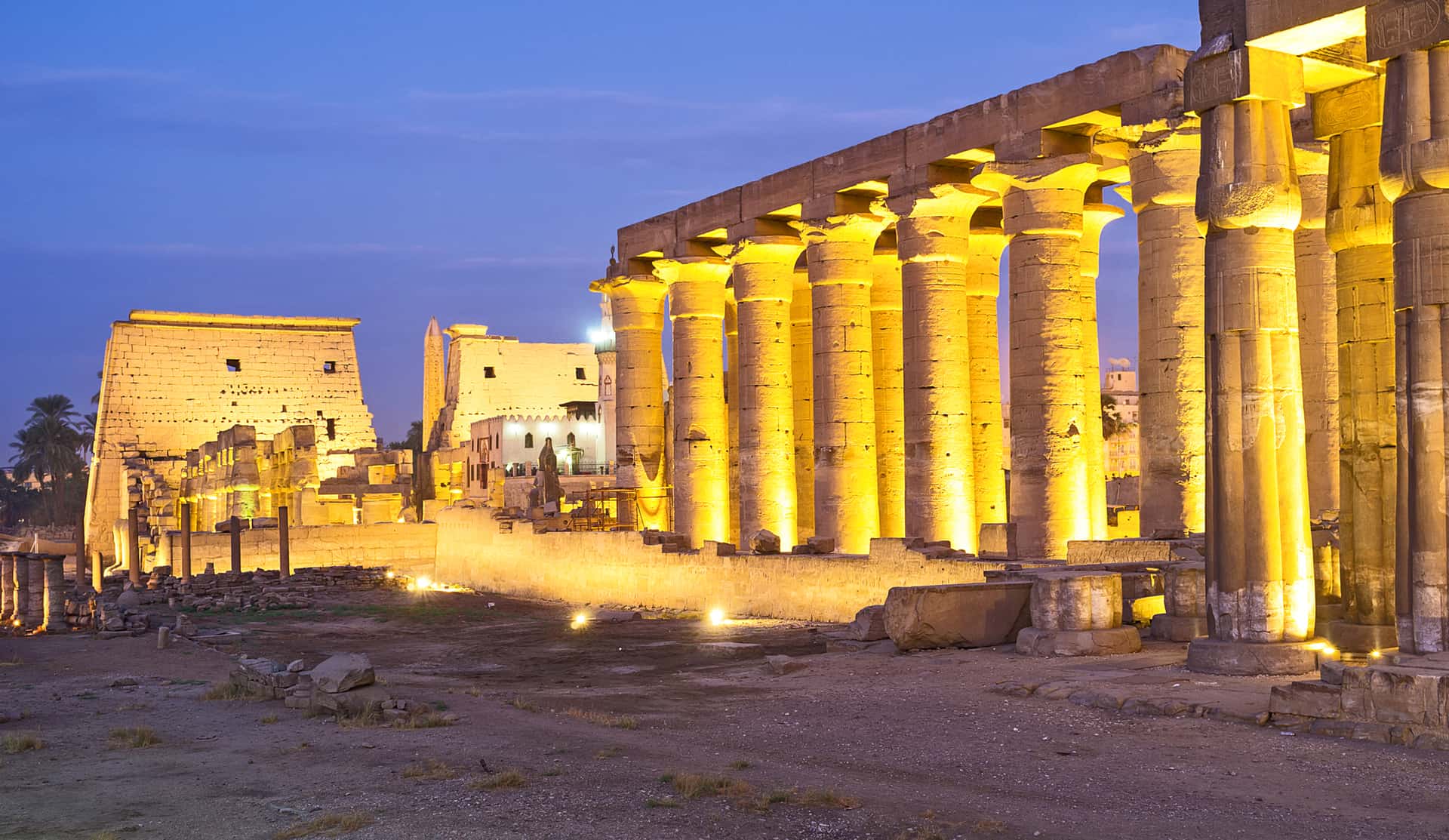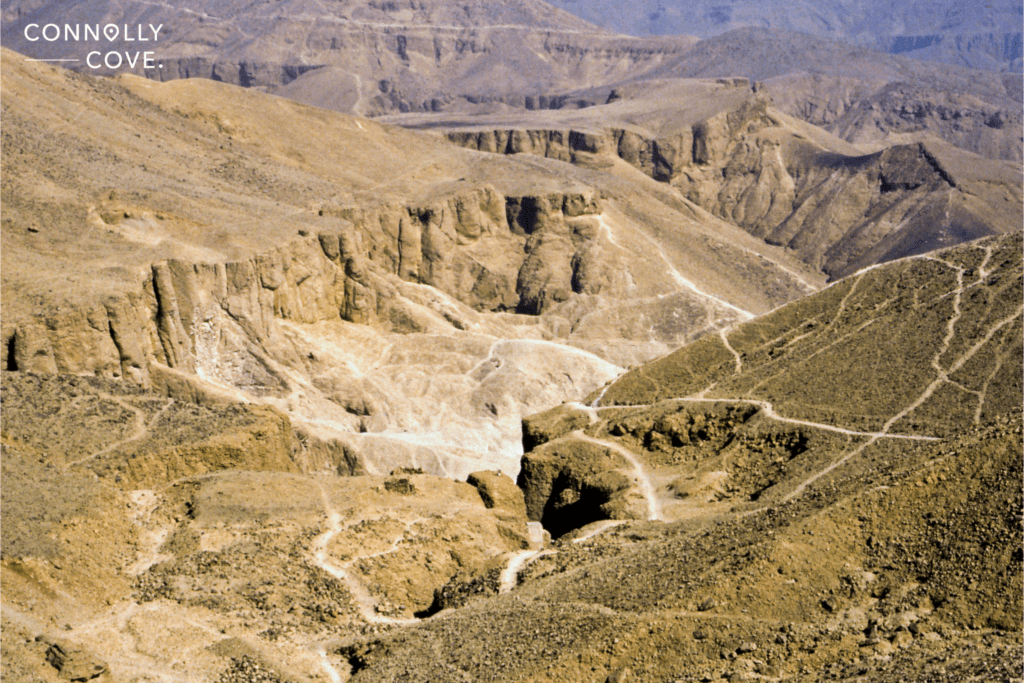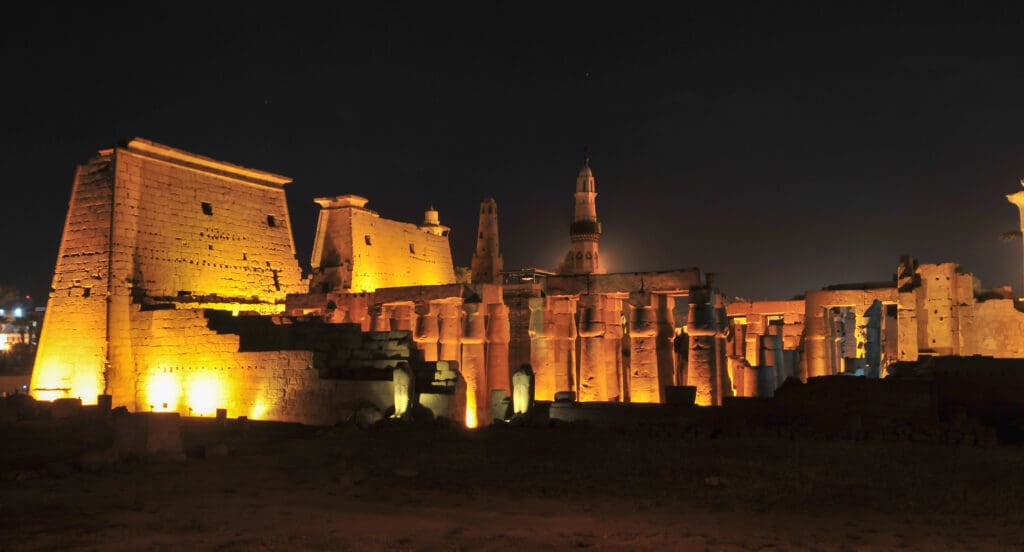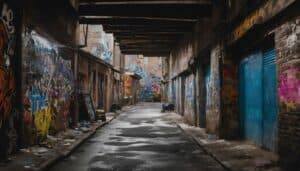World’s Greatest Open Air Museum, Luxor, Egypt

Updated On: April 23, 2024 by Marwa Alaa
Luxor, Egypt, is a city on the east bank of the Nile River that is rich with many historical tombs, museums, monuments, and temples that make it the world’s most excellent open-air museum. Luxor is where the kings and queens of old Egypt were crowned.
Luxor, Egypt, is the city that tourists visit for two reasons: first, it is filled with many historical museums and temples that people are astonished by. Second, being placed by the Nile River gives this city a different look and atmosphere, making people happy with the view they might as well receive from their hotel rooms.
History of Luxor
If Luxor is on the list of your destinations, you are lucky! This city is home to one-third of the world’s monuments! The Greeks called the town “Thebes”, while the ancient Egyptians called it “Waset”. For its significance, the city was the capital of Upper Egypt during the New Kingdom. Luxor is a city that combines the greatness of the past and the present. There stand lots and lots of ancient Egyptian monuments and remains, along with the structures of the modern city.
Being that significant in regards to weather, nature and historical importance among other cities, Luxor attracts thousands of visitors from around the world to explore the greatness of the town and enjoy the open-air museum from the temple of Karnak and Luxor temple to the valley of the kings and the valley of the queens, as well as other beautiful monuments and burials scattered around the city, will take your breath away.
The Nile River mainly locates the extraordinary historical spots of Luxor. The scene cannot be described, but imagine the Nile flowing between the ancient city where the great civilization was built and the modern city. Ancient Egyptian beliefs contributed a lot to the ancient Egyptian civilization, and Luxor is a great example.
Luxor started to attract travellers from the western side of the world by the end of the 18th century.
Luxor Definition
The dictionary defines Luxor as “a city in eastern Egypt, on the east bank of the River Nile.” It is known for being “the site of the southern part of ancient Thebes and contains the ruins of the temple built by Amenhotep III and of monuments erected by Ramses II.” But have you ever thought about the meaning of “Luxor” itself?! If you know Arabic, you might know what it means, but not necessarily. Many native Arabic speakers never thought about the meaning of the word. The name “Luxor” actually comes from the Arabic word “Al-uqsur”, which means “palaces”. This word might be borrowed from the Latin “castrum, ” meaning “fortified camp.”
Valley of the Kings

Valley of the Kings “Wadi Al Molook” in Arabic, also known as the Valley of the Gates of the Kings, is one of the most exciting areas in Egypt. The valley is a royal cemetery that has survived for thousands of years. This place has sixty-three astonishing royal burials with treasures and belongings that have survived since ancient Egypt. The cemetery is located in a particular area on the west bank of the Nile. This area is known for the top of a pyramid-shaped mountain named “Al Qurn”, translated in English as “The Horn”.
Most noteworthy, the Valley of the Kings became a royal burial by the time of the New Kingdom of ancient Egypt (1539 – 1075 B.C.). A valley is a place where many of the most important rulers and significant people in ancient Egypt from the 18th, 19th, and 20th dynasties. These included King Tutankhamun, King Seti I, King Ramses II, and many queens, elites, and higher priests.
As they believed in the afterlife, a new life where good people are promised eternity, and pharaohs are turning to Gods, the ancient Egyptians prepared the burials of the valley with almost everything a person would need in the afterlife. Ancient Egyptians used the mummification method to preserve the bodies of the dead so that the soul could easily find them in the afterlife. They also decorated the tombs of the kings with writings and drawings from ancient Egyptian mythologies, which gives us an image of the modern period and how religious and funerary beliefs were back then. Unfortunately, the tombs were a great attraction to thieves over the years, yet archaeologists found in the tombs of the valley food, beer, wine, jewellery, furniture, clothes, sacred and religious objects, and any other things the dead might need in his afterlife, even their pets.
After discovering 62 tombs in the valley, people thought that was all that could be found in it, until 1922, when Howard Carter, the British archaeologist and Egyptologist, discovered a fantastic burial of a boy king named Tutankhamun who happened to be a pharaoh of the 18th dynasty. Then again, in 2005, Otto Schaden, the American Egyptologist, and his team discovered the first unknown tomb since King Tut’s burial chamber was discovered in 1922. The team found the tomb, KV 63, around 15 meters from the walls of Tut’s burial. The tomb had no mummy, but the team found coffins, flowers, pottery, and other belongings.
What’s impressive about the Valley of the Kings is that it has been an attraction to robbers (almost all the tombs were robbed at some point). Yet, it still surprises us with the beautiful and artistic burials archaeologists find. Some believe the valley will still surprise us with more hidden burials and secrets from ancient Egypt, and we hope it does!
Valley of the Queens
The Valley of Queens, in Arabic, is known as “Wadi Al Malekat” and is another famous cemetery on the west bank of the Nile River in Luxor. The site was created to be a burial site for the wives of the ancient Egyptian pharaohs and princes, princesses, and other noble people. In ancient Egypt, they referred to the Valley of the Queens as “Ta-Set-Neferu”, which means “the place of beauty”. And it’s a place of beauty!
Archaeologist Christian Leblanc divided the Valley of the Queens into many valleys. The central valley hosts most of the tombs (around 91 tombs). Other valleys go as follows: the Valley of the Prince Ahmose, the Valley of the Rope, the Valley of the Three Pits, and the Valley of the Dolmen. Those secondary valleys contain around 19 tombs, all dating back to the 18th dynasty.
These burials include the tomb of Queen Nefertari, the favourite wife of Pharaoh Ramses II. Those who visited the site say that the tomb of Queen Nefertari is one of the most beautiful burials in Egypt. The tomb has beautiful paintings portraying the queen being guided by the Gods.
No one knows why the ancient Egyptians chose this place specifically to be the burial place of the queens. But it might be because it’s relatively close to the Valley of the Kings and the worker’s village in Deir el-Medina. At the entryway of the Valley of the Queens stands the sacred grotto of the great Goddes Hathor, which might also be why the ancient Egyptians picked this place specifically. Some believe that the grotto is related to the restoration of the dead.
Mortuary Temple of Hatshepsut
This is one of the top masterpieces in the history of ancient Egypt. The Mortuary Temple of the famous queen Hatshepsut is an extraordinary construction standing 300 meters on the top of the desert in Al Deir Al Bahari in Luxor. It is located on the west bank of the Nile River near the Valley of the Kings. The temple’s design and architecture have a unique modern touch. The temple is also known as “Djeser-Djeseru”, which means “Holy of Holies”. According to many experts, the temple is considered one of the “incomparable monuments of ancient Egypt.”
The beautiful construction belongs to the Egyptian Queen Hatshepsut from the 18th dynasty. The mortuary temple of Hatshepsut was mainly devoted to God Amun, the God of the sun. Also, the temple’s location is very close to the mortuary temple of Mentuhotep II. Interestingly, the Mentuhotep temple had a role in building the Hatshepsut temple as they used it as both an inspiration and later as a quarry.
The royal architect, Senenmut, built the temple for Queen Hatshepsut. Rumour has it that Senenmut was also Hatshepsut’s lover. The temple’s design is a bit unusual and distinctive, but that’s because it didn’t have all the characteristics of a mortuary temple. However, they had to customize it to the site they chose. The temple lies on the same line as the Temple of Amun and the Shrine of Goddess Hathor.
The Mortuary Temple of Hatshepsut includes pylons, courts, a hypostyle, a sun court, a chapel, and a sanctuary. The excellent construction has been through a lot; many tried to destroy it over the centuries. Interestingly, Christians turned it into a monastery at some point, calling it “Al Deir Al Bahari”, which is translated as “The Monastery of the North”, and that’s why some people still call it Al Deir Al Bahari. The temple site is considered one of the hottest places, so if you’re planning on visiting it you better do it early in the morning. You can also see the details of the temple in low sunlight. The great court will lead you to the complex, where you will find the roots of original ancient trees.
Astronomical Significance
The centre line of the temple is positioned in azimuth of around 116½° and is lined up to the winter solstice sunrise. According to our modern times, this is around the 21st or 22nd of December every year. That’s when the sunlight passes through, reaching the back wall of the chapel, then moves to the right, falling on one of Osiris’s statues, which are positioned on both sides of the entrance of the second chamber.
If you are visiting on these two days, you can be lucky enough to experience the sunlight slowly moving from the central spot of the temple to throw the light on the God Amun Ra, then moving to the statue of the kneeling Thutmose III, then the sun rays will finally throw their lights on the Nile God, Hapi. The magic doesn’t stop at this point; the sunlight reaches the innermost chamber during around 41 days of both sides of the solstice. Furthermore, the Ptolemaic reconstructed the inner chapel of the temple. In this chapel, you can find cult references to Pharaoh Imhotep, the pyramid Djoser’s builder, and Amenhotep, the son of Hapu.
Luxor Temple

Luxor Temple is a huge ancient Egyptian complex on the River Nile’s east bank. The ancient Egyptians built the large chapel around 1400 B.C. Luxor Temple is known in the ancient Egyptian language as “pet resyt” which means “the southern sanctuary”. This chapel is a bit different from the others in Luxor, and it is not built in devotion to a cult God or the worshipped version of the God of Death. But in fact, it’s built for the renewal of kingship.
On the back of the temple are chapels built by Amenhotep III of the 18th Dynasty and Alexander. Kings Tutankhamun and King Ramesses II constructed also other parts of the Luxor temple. The significance of this fantastic construction extends to the Roman period when it was used as a fortress and a house for the Roman regimen and its surrounding parts.
The ancient Egyptians built the temple from sandstone in the Gebel el-Silsila area. This sandstone is also known as “the Nubian sandstone” as it’s brought from the southwestern part of Egypt. This sandstone was used both in the past and the present. The ancient Egyptians used it to construct monuments and reconstruct monuments. These Nubian sandstones are also used in modern times for reconstruction.
What’s magnificent about the ancient Egyptian buildings is that they always have symbolism and illusionism. For instance, a sanctuary inside the temple is shaped like an Anubis Jackal! Also, at the temple entrance, two obelisks weren’t even in height, but if you looked at them, you wouldn’t feel the difference; they would give you the illusion that they were the same height. Those two obelisks are now in the Place de la Concorde in Paris.
The temple wasn’t excavated until 1884. During medieval times and after the Muslims started to inhabit Egypt, some Muslim populations lived inside and around the temple, mainly in the southern part of the mountain. So, as a result of this and the past population, a massive hill of scrap accumulated over time and buried a considerable part of the temple (almost three-quarters of it). The mount was big, and it was around 15 meters in height. In addition to the scrap mountain, there were barracks, shops, houses, huts, and pigeon towers. In 1884, the French Egyptologist Professor Gaston Maspero started to excavate the site and remove everything covering the temple. The process of excavation lasted till 1960.
The ancient Egyptians built the Luxor Temple during the New Kingdom. They mainly devoted it to the Theban Triad of the cult of the Royal Ka: God Amun (the God of the Sun), Goddess Mut (the mother Goddess and the Goddess of water from which everything is born), and God Khonsu (the God of the moon). The temple had great significance during the Opet festival, during which the Thebans paraded with the statue of Amun and Mut between the Karnak temple and the Luxor Temple in celebration of their marriage and fertility.
According to specialists, there are prominent examples of the Royal Ka cult in the temple. For instance, it can be found in the colossal seated statues of the Pharaoh Ramses II placed at the Pylon. Also, at the entry of the Colonnade, there are figures of the king personifying the Royal Ka.
Many great pharaohs contributed to the construction of the temple. King Amenhotep III (1390-1352 BC) built this temple, and then King Tutankhamun (1336-1327 BC) and King Horemoheb (1323-1295 BC) completed it. During his reign, Pharaoh Ramses II (1279-1213 BC) added to it. Interestingly, towards the back of the temple, there is a granite shrine dedicated to Alexander the Great (332-305 BC).
Through time, Luxor temple has been where all the religions passed by; it has been a place of worship until now. During the Christian era, Christians turned the temple’s hypostyle hall into a church. You can see the remnants of another church in the west direction of the temple.
Christianity is not the only religion that took the temple as a place of worship. Streets and buildings covered the temple for thousands of years. At some point in this phase,, Sufis built the mosque of Sufi Shaykh Yusuf Abu Al-Hajjaj over the temple. When the archaeologists uncovered the temple, they ensured they took care of the mosque and did not ruin it.
Avenue of Sphinxes
It is one of the most incredible places in Luxor that you shouldn’t miss! The avenue of the Sphinxes is a pathway of around 1,350 sphinxes with human heads that extends for more than 3 kilometres. This pathway connects both Luxor Temple and Al Karnak Temple. The ancient Egyptians used this avenue during the Opet festival when they paraded along this pathway carrying the figures of the God Amun and the Goddess Mut in a symbolic renewal of their marriage.
The building of the Avenue of Sphinxes started during the New Kingdom and lasted until the 30th Dynasty. Later, during the Ptolemaic Era, Queen Cleopatra reconstructed this pathway. According to historians, there were many stations along the avenue, and they served many purposes. For example, station number four was serving in cooling the oar of Amun; station number five was serving each of those sphinxes had a role of their own, such as cooling the oar of God Amun or receiving the beauty of God Amun.
Karnak Temple Complex
When you visit the famous Temple of Karnak, you will find what an entire ”city” is, all made of a range of ancient wonders. The temple is dedicated to the religious cult complex of the eighteenth dynasty, Theban Triad, Amun, Mut, and Monsu. Coming from the Arabic word ’Khurnak’, which means the ’fortified village’, Karnak comprises temples, towers, chapels, and other constructions built around Luxor in Upper Egypt over 2,000 years ago. As a site occupying approximately 200 acres, it is the largest religious complex ever made.
The old Temple of Karnak must have been glorious in its heyday, but the now derelict place still beats many of our modern-day wonders. It is one of Egypt’s most famous historical sites, and when it comes to the number of visitors each year, it is only topped by the Giza Pyramids on the outskirts of the country’s capital, Cairo.
It comprises four main parts, whereas only the largest are open to public visits. When using the term ”Karnak”, people usually refer to the single Precinct of Amun-Ra only, as it is the only part tourists see. The Precinct of Mut, the Precinct of Montu, and the demolished Temple of Amenhotep IV are closed off from the general visitor.
By the ancient Egyptians, the area surrounding the Karnak Complex is known as Ipet-isu – the “most selected of places”. The complex is part of the city of Thebes, the primary place of worship of the God triad with Amun as its head. You will also find the Karnak Open Air Museum in the vast open area.
A remarkable characteristic of the Karnak is its historical period of development and usage. It dates from around 2055 BC to approximately 100 AD, so its first construction was initiated in the Middle Kingdom and developed into Ptomelaic times. No less than around thirty pharaohs have put their visions and work into these buildings, and what will meet the visitor today is a religious site that stands out from most other ancient monuments in Egypt.
Each of the architectural and aesthetic elements of Karnak may in itself not be unique; instead, it is the number and manifold range of features, as well as their collective complexity, that will make you lose your breath. The divine figures represented in these buildings include those known and worshipped from the earliest of times, as well as deities from much later in the history of Ancient Egypt.
In terms of religious richness, then, the Karnak temples are overwhelming. For the Ancient Egyptian people, this could only have been a place solely for and of the Gods. Regarding mere size, the enclosure of the Precinct Amun-Ra alone can, with its sixty-one acres, house ten regular European cathedrals. The great temple at Karnak’s centre is of immensity, allowing Rome’s St. Peter’s Cathedral, Milan’s Cathedral, and the Notre Dame in Paris to fit within its walls all at once. Besides the main sanctuary, the Karnak complex is the home of numerous smaller temples as well as a majestic lake of 423 feet by 252 feet, or 129 by 77 meters.
Also, in terms of cultural history, the site played a significant role in the time of Ancient Egypt. For two millennia, pilgrims flocked from afar to the worshipped place of Karnak. Together with its neighbouring city, Luxor, the site of Karnak set the stage for the remarkable Opet Festival. According to Ancient Egyptian belief, the powers of the Gods and the Earth would weaken towards the end of each annual agricultural cycle. Religious rituals were performed at the Beautiful Feast of Opet, held in Thebes each year to provide both with new cosmic energy. What served as a magical regeneration was also a twenty-seven-day celebration of the divine connection between the Pharaoh and the head of the Theban Triad, the God Amun.
The sculpture of Amun was cleansed in holy water and ornamented with delicate garments and jewellery in gold and silver. First, priests put the statue in a shrine and placed it in a ceremonial barque. Pharaoh stepped out from the Temple of Karnak, and as his priests carried the barque on their shoulders by supporting poles, they all proceeded through the crowded streets of the celebrating people. Along with the masses, troops of Nubian soldiers marched and beat their drums, musicians played and joined the priests in song, and the air filled with joyous noise and the smell of incense.
When they reached Luxor, the Pharaoh and his priests entered the holy temple of Luxor, performing ceremonies of regeneration. With these, Amun was believed to receive energy anew, his power was transferred to Pharaoh, and the cosmos was restored to its optimal fashion. When Pharaoh emerged again from the temple sanctuary, the masses cheered him. At this stage, the celebrations would peak as the earth’s fertility was again secured, and the people praised the expectation of a healthy harvest and future abundance. As a part of the celebration, the higher authorities would give the public around 11,000 loaves of bread and around 385 jars of beer. Priests would also allow some people to the temple to ask God’s questions, and they would answer them through hidden windows high up in the wall or from inside the statues.
The Beautiful Feast of Opet is said to have been beautiful indeed. It was a celebration that gathered the people, and for the Ancient Egyptians, rituals like these were paramount for sustaining life on earth and life beyond it. When you visit Karnak, you will not only meet religious monuments showcasing any less than thousands of years of Ancient Egyptian architecture – you will also find yourself centre stage at a site that encompasses holy and life-important traditions for the old Egyptian people. These traditions are culturally and historically significant also when we are to understand Ancient Egypt today.
Karnak Temple Hypostyle Hall
Hypostyle Hall is one of the most famous parts of the Karnak Museum in the Precinct of Amun-Re. The area of the hall measures around 50,000 sq ft and hosts 134 massive columns positioned in 16 rows. Regarding the length, we can find that 122 columns of the 134 massive columns in the temple are 10 meters tall, while the other 21 columns are 21 meters tall, and their diameter is around 3 meters. Pharaoh Seti I was the one who built the hall and created the inscriptions in the northern wing.
The exterior walls portray the battles of Seti I. Moreover, Pharaoh Ramesses II completed the southern part of the hall. On the south wall are inscriptions documenting Ramesses II’s peace treaty with the Hittites. Ramesses signed this peace treaty in the 21st year of his reign. Pharaohs who came after Seti I and Ramesses II, including Ramesses III, Ramesses IV, and Ramesses VI, contributed to the inscriptions found now on the walls of the hypostyle as well as the columns.
The Kiosk of Tahraqa
Do you know who Tahraqa is?! Tahraqa is the 4th king of the 25th Dynasty (690-664 B.C). Tahraqa was also king of the Kush Kingdom (Kush was an ancient kingdom in Nubia and was located in Northern Sudan and the Southern Egyptian Nile Valley). When the Pharaoh originally constructed this Kiosk, it consisted of 10 high papyrus columns, each one of which is 21 meters high. The papyrus columns are connected with a low screening wall. Unfortunately, in modern times, there is only one column remaining. Some Egyptologists believe that ancient Egyptians used it for rituals to join the sun.
Precinct of Amun-Re
This is the largest of the precincts of the temple complex and is dedicated to Amun-Re, the chief deity of the Theban Triad. There are several colossal statues, including the figure of Pinedjem I, which is 10.5 meters tall. The sandstone for this temple, including all the columns, was transported from Gebel Silsila 100 miles (161 km) south on the Nile River.[8] It also has one of the most enormous obelisks, weighing 328 tonnes and 29 meters tall.
Precinct of Mut
Located to the south of the newer Amen-Re complex, this precinct was dedicated to the mother goddess, Mut, who became identified as the wife of Amun-Re in the eighteenth dynasty Theban Triad. It has several smaller temples associated with it and has its sacred lake constructed in a crescent shape. This temple has been ravaged, many portions having been used in other structures. Following excavation and restoration works by the Johns Hopkins University team, led by Betsy Bryan (see below) the Precinct of Mut has been opened to the public. Six hundred black granite statues were found in the courtyard of her temple. It may be the oldest portion of the site.
Precinct of Montu
The area covers about 20,000 m². Most monuments are poorly preserved.
The main features of the Precinct of Montu are the Temple of Montu, Temple of Harpre, Temple of Ma’at, a sacred lake and the Gateway of Ptolemy III Euergetes / Ptolemy IV Philopator, which is the most visible structure on the site and can be easily seen from inside the Precinct of Amon-Re. This gateway is also called Bab el’Adb.
The temple of Montu consisted of the traditional parts of an Egyptian temple with a pylon, court and rooms filled with columns. The ruins of the temple date back to the reign of Amenhotep III, who rebuilt the sanctuary. This date dates back to the Middle Kingdom era and is dedicated it to Montu-Re. Ramesses II increased the size of the temple by adding a forecourt and erecting two obelisks there. A large court with a gantry gave on hypostyle open on the court, characteristic of the buildings of the reign of Amenhotep I. The sanctuary is made up as follows: a room with four columns serving various vaults of worship and giving on the boat’s room, which preceded the naos by the god. Another Temple of Montu was nearby in Medamud.
Luxor Museum
Luxor Museum is an archaeological museum in Luxor (ancient Thebes), Egypt. It stands on the corniche, overlooking the west bank of the River Nile. One of Egypt’s best displays of antiquities is located at the Luxor Museum, which opened in 1975. Housed within a modern building, the collection is limited in the number of items, but they are beautifully displayed.
The admission price is high, but it is well worth the visit. Visiting hours can be restricted, so find out when you arrive in Luxor. Upon entering the museum, a small gift shop is on the right. Once inside the main museum area, two of the first items that catch one’s attention are the enormous red granite head of Amenhotep III and the cow-goddess head from the tomb of Tutankhamun.
Spaced out around the ground floor are masterpieces of sculpture, including a calcite double statue of the crocodile god Sobek and the 18th Dynasty pharaoh Amenhotep III (below suitable). It was discovered at the bottom of a water-filled shaft in 1967. A ramp leads upstairs to more marvellous antiquities, including some items from Tutankhamun’s tomb, such as boats, sandals and arrows.
One of the significant items of the whole museum is located upstairs – a reassembled wall of 283 painted sandstone blocks from a wall in the dismantled temple built at Karnak for Amenhotep IV (the heretic king Akhenaten of the 18th Dynasty). Numerous other antiquities are interesting, including a few lovely coffins. The museum also houses items from periods after the demise of pharaonic Egypt.
On returning to the ground floor, there is a gallery on the left (outbound) with a beautiful collection of stone sculptures found in 1989 under one of the courtyards within Luxor Temple. Among the items on display are grave goods from the tomb of the 18th dynasty pharaoh Tutankhamun (KV62) and a collection of 26 New Kingdom statues that were found buried in the Luxor statue cache in the nearby Luxor Temple in 1989.
The royal mummies of two pharaohs – Ahmose I and Ramesses I – were also displayed in the Luxor Museum in March 2004 as part of the new extension to the museum, which includes a small visitor centre. A central exhibit is a reconstruction of one of the walls of Akhenaten’s temple at Karnak. One of the featured items in the collection is a calcite double statue of the crocodile god Sobek and the 18th Dynasty pharaoh Amenhotep III
Mummification Museum
The Mummification Museum is an archaeological museum in Luxor, Upper Egypt. It is dedicated to the art of Ancient Egyptian mummification. The museum is located in the city of Luxor, the ancient Thebes. It stands on the corniche in front of the Mina Palace Hotel, situated north of the Luxor Temple overlooking the Nile River. The museum is intended to provide visitors with an understanding of the ancient art of mummification.[1] The Ancient Egyptians applied embalming techniques to many species, not only to dead humans. Mummies of cats, fish and crocodiles are on display in this unique museum, where one can also get an idea of the tools used.
The Mummification Museum has well-presented exhibits explaining the art of mummification. The museum is small, and some may find the entrance fee overpriced.
The well-preserved mummy of a 21st-dynasty high priest of Amun, Maserharti, and a host of mummified animals is on display. Vitrines show the tools and materials used in the mummification process – check out the small spoon and metal spatula used for scraping the brain out of the skull. Several artefacts are crucial to the mummy’s journey to the afterlife and some picturesque painted coffins have also been included. Presiding over the entrance is a beautiful little statue of the jackal god, Anubis, the god of embalming who helped Isis turn her brother-husband Osiris into the first mummy.
The hall of artefacts is divided into two parts; the first one is an ascended corridor through which the visitor can have a look at ten tablets were drawn from the papyri of Ani and Hu-nefer that displayed in the British Museum in London. Most of these tablets throw lights on the funeral journey from death to burial. The second part of the museum began at the end of the corridor, and visitors could see more than sixty pieces displayed in 19 well-advanced cases.
In those 19 display cases, the artefacts are concentrated on eleven topics:
• Gods of ancient Egypt
• Embalming materials
• Organic materials
• Embalming fluid
• Tools of mummification
• Canopic jars
• Ushabtis
• Amulets
• Coffin of Padiamun
• Mummy of Masaharta
• Mummified animals
Tombs of the Nobles
The Theban Necropolis is located on the west bank of the Nile, opposite Luxor, in Egypt. As well as the more famous royal tombs located in the Valley of the Kings and Queens, there are numerous other tombs, more commonly referred to as Tombs of the Nobles, the burial places of some of the powerful courtiers and persons of the ancient city.
There are at least 415 catalogued tombs, designated TT for Theban Tomb. There are other tombs whose position has been lost or, for some other reason, do not conform to this classification. See for instance, the List of MMA Tombs. Theban tombs tended to have clay Funerary cones placed over the entrance of the tomb chapels. During the New Kingdom, they were inscribed with the title and name of the tomb owner, sometimes with short prayers. Of the 400 recorded sets of cones, only about 80 come from catalogued tombs.
These tombs are some of the best least-visited attractions on the West Bank. Nestled in the foothills opposite the Ramesseum are more than 400 tombs belonging to nobles from the 6th dynasty to the Graeco-Roman period. Where royal tombs were decorated with cryptic passages from the Book of the Dead to guide them through the afterlife, the nobles, intent on letting the excellent life continue after their death, decorated their tombs with wonderfully detailed scenes of their daily lives.
Several discoveries have been made on the hillside recently, but these tombs are still being studied. Tombs open to the public are divided into groups, and each group requires a separate ticket (various prices) from the Antiquities Inspectorate ticket office. The groups are the Tombs of Khonsu, Userhet and Benia; the Tombs of Menna, Nakht and Amenenope; the Tombs of Ramose, Userhet and Khaemhet; Tombs of Sennofer and Rekhmire; and Tombs of Neferronpet, Dhutmosi and Nefersekheru.
The City of Habu
Medinet Habu (Arabic: مدينة هابو; Egyptian: Tjamet or Djamet; Coptic: Djeme or Djemi) is an archaeological locality situated near the foot of the Theban Hills on the West Bank of the River Nile opposite the modern city of Luxor, Egypt. Although other structures are located within the area, the location is today associated almost exclusively (and indeed, most synonymously) with the Mortuary Temple of Ramesses III.
The Mortuary Temple of Ramesses III at Medinet Habu is an important New Kingdom period structure in Egypt’s West Bank of Luxor. Aside from its size and architectural and artistic importance, the temple is probably best known as the source of inscribed reliefs depicting the advent and defeat of the Sea Peoples during the reign of Ramesses III.
Ramses III’s magnificent memorial temple of Medinat Habu, fronted by sleepy Kom Lolah village and backed by the Theban mountains, is one of the west bank’s most underrated sites. This was one of the first places in Thebes closely associated with the local god Amun. At its height, Medinat Habu contained temples, storage rooms, workshops, administrative buildings, a royal palace and accommodation for priests and officials. It was the centre of the economic life of Thebes for centuries.
Although the complex is most famous for the funerary temple built by Ramses III, Hatshepsut and Tuthmosis III also constructed buildings here. The first European to describe the temple in modern literature was Vivant Denon, who visited the temple in 1799-1801.[1] Champollion described the temple in detail in 1829
Deir El Madina (Worker’s Village)
Deir el-Medina (Egyptian Arabic: دير المدينة) is an ancient Egyptian village which was home to the artisans who worked on the tombs in the Valley of the Kings during the 18th to 20th dynasties of the New Kingdom of Egypt (ca. 1550–1080 BCE)[2] The settlement’s ancient name was Set maat “The Place of Truth”, and the workmen who lived there were called “Servants in place of Truth”.[3] During the Christian era, the temple of Hathor was converted into a church from which the Egyptian Arabic name Deir el-Medina (“the monastery of the town”) is derived.[4]
At the time when the world’s press was concentrating on Howard Carter’s discovery of the Tomb of Tutankhamun in 1922, a team led by Bernard Bruyèrebegan to excavate the site.[5] This work has resulted in one of the most thoroughly documented accounts of community life in the ancient world that spans almost four hundred years. There is no comparable site where a community’s organisation, social interactions, and working and living conditions can be studied in such detail.[6]
The site is located on the west bank of the Nile, across the river from modern-day Luxor.[7] The village is laid out in a small natural amphitheatre, within easy walking distance of the Valley of the Kings to the north, funerary temples to the east and southeast, and the Valley of the Queens to the west.[8] The village may have been built apart from the wider population to preserve secrecy,
given the sensitive nature of the work carried out in the tombs
Unlike most villages in ancient Egypt, which grew organically from small settlements, Deir el-Medina was a planned community. Amenhotep I founded it (c.1541-1520 BCE) specifically to house workers on royal tombs because tomb desecration and robbery had become a severe concern by his time. It was decided that the royalty of Egypt would no longer advertise their final resting places with significant monuments but, instead, would be buried in a less accessible area in tombs cut into the cliff walls.
These areas would become the necropolises now known as the Valley of the Kings and the Valley of the Queens, and those who lived in the village were known as “Servants in the Place of Truth” for their essential role in creating eternal homes and also remaining discreet regarding tomb contents and location.
Deir el-Medina is among Egypt’s most important archaeological sites because of the information it provides on the daily life of the people there. Serious excavation at the site was begun in 1905 CE by the Italian archaeologist Ernesto Schiaparelli and furthered by several others throughout the 20th century CE, with some of the most extensive work done by French archaeologist Bernard Bruyere between 1922 and 1940 CE. At the same time, Howard Carter was bringing the treasures of royalty to light from Tutankhamun’s tomb, and Bruyere was uncovering the lives of the working people who would have created that final resting place.
Malkata
Malkata (or Malqata), where things are picked up in Arabic, is the site of an Ancient Egyptian palace complex built during the New Kingdom by the 18th Dynasty Pharaoh Amenhotep III. It is located on the West Bank of the Nile at Thebes, Upper Egypt, in the desert south of Medinet Habu. The site also included a temple dedicated to Amenhotep III’s Great Royal Wife, Tiy, and honours Sobek, the crocodile deity.
In all that remains to us of ancient Egypt, the homes of the dead and the gods have fared far better than those of the living. However, the vast site of the palace of Malkata, which now lies in ruins, is one of the few places capable of hinting at the splendour of the pharaohs’ lives.
Courtyards, audience chambers, harems, and a gigantic ceremonial lake have been discovered at the Malkata site. Researchers have found that the walls were covered with bright, delicate paintings, some faintly visible. Animals, flowers, and the reed beds along the Nile were all depicted on the walls of the pharaoh’s grand estate. Malkata was a home on the scale of a city, except it was built for a single ruler. Amenhotep’s wife had her wing of the vast estate, and the artificial lake was built strictly so the ruler and family could sail on it. The site was so large that there was even a set of apartments known as the “West Villas” that would have housed the various workers and staff on site.
Today, the ruins of Malkata stretch across the desert close to Thebes, still marking the pinnacle of Amenhotep’s 3,000-year-old empire.
Colossi of Memnon
The Colossi of Memnon (el-Colossat or el-Salamat) are two monumental statues representing Amenhotep III (1386-1353 BCE) of the 18th Dynasty of Egypt. They are located west of the modern city of Luxor and face east, looking toward the Nile River. The statues depict the seated king on a throne ornamented with imagery of his mother, his wife, the god Hapy, and other symbolic engravings. The figures rise 60 ft (18 meters) high and weigh 720 tons each, carved from single sandstone blocks.
They were constructed as guardians for Amenhotep III’s mortuary complex, which once stood behind them. Earthquakes, floods, and the ancient practice of using older monuments and buildings as resource material for new structures all contributed to the disappearance of the enormous complex. Little of it remains today except for the two colossal statues which once stood at its gates.
Their name comes from the Greek hero Memnon, who fell at Troy. Memnon was an Ethiopian king who joined the battle on the side of the Trojans against the Greeks and was killed by the Greek champion Achilles. However, Memnon’s courage and skill in battle elevated him to the status of a hero among the Greeks. Seeing the impressive statues, Greek tourists associated them with the legend of Memnon instead of Amenhotep III. This link was also suggested by the 3rd-century BCE Egyptian historian Manetho, who claimed Memnon and Amenhotep III were the same people.
The Greek historian described the two statues as follows:
“Here are two colossi, which are near one another and are each made of a single stone; one of them is preserved, but the upper parts of the other, from the seat up, fell when an earthquake took place, so it is said. It is believed that once each day, a noise, as of a slight blow, emanates from the part of the latter that remains on the throne and its base, and I, too, when I was present at the place with Aelius Gallus and his crowd of associates, both friends and soldiers, heard the noise at about the first hour. (XVII.46)”
Shopping in Luxor
Things to Do in Luxor at Night
How many days do you need in Luxor?
Well, as you see yourself, Luxor has many secrets and treasures to discover daily. For a place like Luxor, we can tell you to spend there as many days as possible. Or maybe forever?! Don’t blame yourself if you want to stay there forever; it’s worth it! If you’re coming to Egypt for a short visit, you better have at least a week for Luxor. Try to travel there using a Nile cruise; the experience is different, and you’ll appreciate it. We’re talking about one-third of the monuments worldwide, so a week is only fair. Luxor doesn’t only have ancient Egyptian monuments for you to enjoy. You can also enjoy other activities there. You can spend some time strolling around the markets in Luxor and shop for handmade artefacts, clothes, silver products, and herpes. You can also enjoy a night by the Nile and ride the cabriolet.






